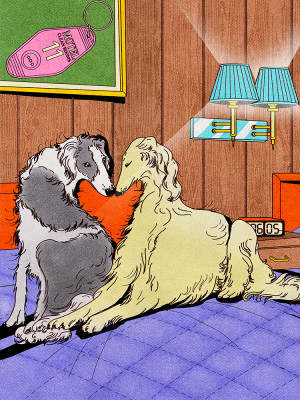
What Happens When the Love of Your Life Is Allergic to the Other Love of Your Life?
You don’t have to choose between your SO and your dog or cat – but here’s what may need to happen

Share Article
Heavy Petting is a weekly column full of relationship advice for pet parents – so you and your boo don’t end up fighting like cats and dogs over the cat and dog.
Here’s a tragedy about impossible love, on the dramatic scale of Romeo and Juliet. Two beautiful souls fall into a beautiful romance. But! Something neither of them can change about their circumstance keeps them apart: One of the lovers has an abnormal immune reaction to proteins found in the other person’s pet’s dander, saliva or other excretions (already an unsexy word!). In the presence of their love’s beloved animal, their eyes itch, their head aches, their nose runs. Sneezes burst forth, hives bloom, the face swells.

littleKin™ is Kinship’s home just for puppy and kitten parents. Bop over to check out expert advice, new pet tools, and special deals—all curated for your newest family member.
opens in a new tabIn other words, they’re allergic to their partner’s pet. What now? Are they doomed to a fate as star-crossed lovers? Not necessarily – but everyone has a different approach to love and pet allergies. Let’s jump in.
Stopping the aches (head and heart) before they start
For a period of time, my friend Jules, had the following written on her dating profile: “The worst thing about me, I’m allergic to cats” followed by a sobbing emoji. “I think people interpreted that emoji as communication that cats made my eyes water, which they do – but I meant it like, It’s so sad that I can’t live with a cat.”
Jules has always wanted to spend more time with them, but her sinuses will explode. “Dating as a queer woman who likes queer women, I feel like I’m cutting out, I don’t know, 60 percent of the pool by not dating people with cats,” she says. “I can cry over that, too.”
Jules is smart to try to ward off love before it starts, but we can’t control matters of the heart. Sometimes, the allergic just happen to fall for someone who also happens to have samples of their allergens all over their house and clothes. I have a friend with a dog who’s dating someone with a mild dog allergy. Thankfully, my allergic friend has a workaround.
“As long as Leggy doesn’t lick my skin, then I’m fine,” my friend says. Ideally, she wouldn’t spend her evening hours evading a rash for the rest of her life. But also ideally, she would spend her life with her favourite person and a dog she adores – which she does.
One partner’s allergy isn’t the type of problem you can really sort out through reasoned, supportive conversation. In some cases, asking for a compromise is impossible. Early on in the relationship, you can sleep over at their place where the allergen isn’t. But, eventually, you may want to live together, so a very hard conversation is probably on the horizon. It seems like either one person suffers through terrible discomfort in their home or someone’s pet needs to find a new home. This is a lose-lose if there ever was one.
Kelly Scott, a couple’s therapistopens in a new tab with Tribeca Therapyopens in a new tab, has witnessed this in one couple in particular, where a cat allergy was preventing a couple from moving in together. “It became a big lightning rod in the relationship. There was all of this debate over it. One person is saying, ‘If you love me you'd rehome the cats,’ and the other person is saying, ‘If you love me you’d get allergy injections, because you know how important the cats are to me.’”
There were a lot of expectations of sacrifice and a lot of standstill about it. “It became this huge symbolic fight between the two of them,” says Scott. “It was about the cats, but it was also very much not about the cat. It was about: what does it mean for you to love me? What does it mean for me to love you?”
Hilary, the senior editor at Kinship, has some firsthand experience with all of this. She got her first dog – a red spotted Cattle Dog mix, Georgie, who’s, in Hilary’s words, “too smart for her own good” – in 2018. Two years later, during lockdown when Hilary was home with Georgie all the time, Hilary noticed that her pollen allergies had gotten really brutal.
When she finally got allergen tests, only one popped up: canine. And when Hilary’s partner heard the news, they cried immediately, fearing the worst – that the couple might have to give up Georgie. (I’ll spare your worries and give you a spoiler, especially because there’s a fun twist: Georgie sticks around.)
Allergies: a little more complicated than they seem
It turns out that allergies are just as nuanced as relationships. It’s good to establish the nuances of pet allergies, because rumours abound. A good one I heard recently is that most people who are allergic to dogs are only allergic to male dogs, and shockingly it can be true.
For some explanations, we spoke to allergist Dr Shaan Waqaropens in a new tab, with the ENT and Allergy Associates. He says the majority of people who have pet allergies are allergic to dander, but people can also be allergic to a pet’s salvia and urine. And as for male dogs, some patients who have one particular isolated protein allergy can tolerate female dogs better, as that protein is made in the prostate of male dogs.
Hypoallergenic is a myth
Dr Waqar also notes that, despite a great marketing scheme occurring over decades, there’s really no such thing as hypoallergenic dogs. “When they’re studied in the real world, patients’ homes still have the same amount of allergic dander.” There can be variability within the species, but “as of today, there’s really no true hypoallergenic dog breed at this point in time”.
But it’s very possible some specific dogs will shed less than others within a breed, producing less dander, and therefore fewer symptoms in the allergic party. So anecdotally, someone will have luck with a particular dog – or they are lucky and a little bit of continual exposure is enough to ease their symptoms. (What’s more, Dr Waqa adds, as people age, their allergen responses can slow or stop altogether.)
But there are solutions! The first is the trickiest, because it can either ease or exacerbate the problem: exposure. For some people, living with a pet can boost tolerance, Dr Waqar says. But for others “continuous exposure tends to be the basis of creating that allergic sensitisation and progresses to clinical allergy”.
Some actionable solutions
Dr Waqar says the first step for living with a pet you’re allergic to is to take some environmental approaches. The pet could be restricted to a few rooms, and especially kept out of the bedroom. If you are the partner with the pet allergy, you should wash hands after interacting with the animal. And – prepare for a potential squabble with your pet every Sunday night – but bathing the dog or cat once a week will reduce dander spread. Carpets should be vacuumed once or twice a week, and home air filters subbed out every three months.
For medical interventions, many people do well with simple oral antihistamines and maybe the addition of some nasal sprays. For the final intervention – the big guns – Dr Waqar says patients can pursue allergy injections. These have the ability to halt allergies entirely.
“The goal is to switch the patient’s allergic profile to a non-allergic profile by building up gradually to higher doses and building tolerance over time,” says Dr Waqar. After the initial treatment, patients will usually move to a monthly maintenance dose phase. And, he adds: “Many can stop monthly maintenance at the three or five-year phase”, when their allergy subsides.
The couple with the cat allergy, decided to rehome the cats – and the decision remains a source of resentments that comes up frequently. But I’m not going to end this with a total bummer. Here’s a happy ending: Hilary is now three years into allergy injections and has even added another dog to the mix (Charlie, “a totally deaf, goofball, Velcro dog” who insists on sticking right to Hilary). And while the second dog might have added a little set-back, in general, Hilary feels much less like there’s a horrible over-full balloon hiding in her nasal passages.
So, the moral of this sniffly, mucus-y love story is this: you may have to make some sacrifices. These could be weekly injections, restricting your pet to a designated space or upping the ante on the vacuuming. But the pet can stay.

Maggie Lange
Maggie Lange is a writer, editor, and columnist. Her work has been featured in New York Magazine, Vice, Guernica, GQ, Rolling Stone, Pitchfork, Elle, and Bon Appetit. She lives in Philadelphia with her favorite brindle boy, Finn.
Related articles
- opens in a new tab
Should You Kick Your Pet Out of the Room When You Have Sex?
And what to do if you and your partner can’t agree on whether you should have an audience
![an illustration of a cat with various cat chores: being groomed, scooping the litter box, feeding the cat]() opens in a new tab
opens in a new tabWhat to Do When Your Partner Isn’t Pulling Their Weight With Your Pet
So you don’t have to be annoyed anymore
![a white dog stares up at a pink dress and yellow dress waving outside in the wind on a clothing line]() opens in a new tab
opens in a new tabWhen Is It Too Early to Get a Dog Together?
You’re in love, but is it irresponsible to add four paws to the mix?
![An illustration of 2 dogs on a bed]() opens in a new tab
opens in a new tabThree’s a Crowd: When One Partner Doesn’t Want the Dog in the Bed
You want them to cuddle up; your partner doesn’t. Here’s how to handle the great bed debate






